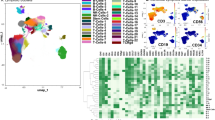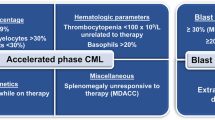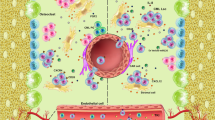Abstract
Chronic myeloid leukemia (CML) stem cells appear resistant to tyrosine kinase inhibitors (TKIs) in vitro, but their impact and drug sensitivity in vivo has not been systematically assessed. We prospectively analyzed the proportion of Philadelphia chromosome-positive leukemic stem cells (LSCs, Ph+CD34+CD38−) and progenitor cells (LPCs, Ph+CD34+CD38+) from 46 newly diagnosed CML patients both at the diagnosis and during imatinib or dasatinib therapy (ClinicalTrials.gov NCT00852566). At diagnosis, the proportion of LSCs varied markedly (1–100%) between individual patients with a significantly lower median value as compared with LPCs (79% vs 96%, respectively, P=0.0001). The LSC burden correlated with leukocyte count, spleen size, hemoglobin and blast percentage. A low initial LSC percentage was associated with less therapy-related hematological toxicity and superior cytogenetic and molecular responses. After initiation of TKI therapy, the LPCs and LSCs rapidly decreased in both therapy groups, but at 3 months time point the median LPC level was significantly lower in dasatinib group compared with imatinib patients (0.05% vs 0.68%, P=0.032). These data detail for the first time the prognostic significance of the LSC burden at diagnosis and show that in contrast to in vitro data, TKI therapy rapidly eradicates the majority of LSCs in patients.
This is a preview of subscription content, access via your institution
Access options
Subscribe to this journal
Receive 12 print issues and online access
$259.00 per year
only $21.58 per issue
Buy this article
- Purchase on Springer Link
- Instant access to full article PDF
Prices may be subject to local taxes which are calculated during checkout






Similar content being viewed by others
References
Bixby D, Talpaz M . Seeking the causes and solutions to imatinib-resistance in chronic myeloid leukemia. Leukemia 2011; 25: 7–22.
Cortes J, Kim DW, Raffoux E, Martinelli G, Ritchie E, Roy L et al. Efficacy and safety of dasatinib in imatinib-resistant or -intolerant patients with chronic myeloid leukemia in blast phase. Leukemia 2008; 22: 2176–2183.
Druker BJ, Guilhot F, O'Brien SG, Gathmann I, Kantarjian H, Gattermann N et al. Five-year follow-up of patients receiving imatinib for chronic myeloid leukemia. N Engl J Med 2006; 355: 2408–2417.
Hochhaus A, Baccarani M, Deininger M, Apperley JF, Lipton JH, Goldberg SL et al. Dasatinib induces durable cytogenetic responses in patients with chronic myelogenous leukemia in chronic phase with resistance or intolerance to imatinib. Leukemia 2008; 22: 1200–1206.
Kantarjian H, Shah NP, Hochhaus A, Cortes J, Shah S, Ayala M et al. Dasatinib versus imatinib in newly diagnosed chronic-phase chronic myeloid leukemia. N Engl J Med 2010; 362: 2260–2270.
le Coutre PD, Giles FJ, Hochhaus A, Apperley JF, Ossenkoppele GJ, Blakesley R et al. Nilotinib in patients with Ph+ chronic myeloid leukemia in accelerated phase following imatinib resistance or intolerance: 24-month follow-up results. Leukemia 2012; 26: 1189–1194.
Saglio G, Kim DW, Issaragrisil S, le Coutre P, Etienne G, Lobo C et al. Nilotinib versus imatinib for newly diagnosed chronic myeloid leukemia. N Engl J Med 2010; 362: 2251–2259.
Shami PJ, Deininger M . Evolving treatment strategies for patients newly diagnosed with chronic myeloid leukemia: the role of second-generation BCR-ABL inhibitors as first-line therapy. Leukemia 2012; 26: 214–224.
Graham SM, Jorgensen HG, Allan E, Pearson C, Alcorn MJ, Richmond L et al. Primitive, quiescent, Philadelphia-positive stem cells from patients with chronic myeloid leukemia are insensitive to STI571 in vitro. Blood 2002; 99: 319–325.
Copland M, Hamilton A, Elrick LJ, Baird JW, Allan EK, Jordanides N et al. Dasatinib (BMS-354825) targets an earlier progenitor population than imatinib in primary CML but does not eliminate the quiescent fraction. Blood 2006; 107: 4532–4539.
Sloma I, Jiang X, Eaves AC, Eaves CJ . Insights into the stem cells of chronic myeloid leukemia. Leukemia 2010; 24: 1823–1833.
Jiang X, Zhao Y, Smith C, Gasparetto M, Turhan A, Eaves A et al. Chronic myeloid leukemia stem cells possess multiple unique features of resistance to BCR-ABL targeted therapies. Leukemia 2007; 21: 926–935.
Hamilton A, Helgason GV, Schemionek M, Zhang B, Myssina S, Allan EK et al. Chronic myeloid leukemia stem cells are not dependent on Bcr-Abl kinase activity for their survival. Blood 2012; 119: 1501–1510.
Corbin AS, Agarwal A, Loriaux M, Cortes J, Deininger MW, Druker BJ . Human chronic myeloid leukemia stem cells are insensitive to imatinib despite inhibition of BCR-ABL activity. J Clin Invest 2011; 121: 396–409.
Chen Y, Peng C, Sullivan C, Li D, Li S . Critical molecular pathways in cancer stem cells of chronic myeloid leukemia. Leukemia 2010; 24: 1545–1554.
Bhatia R, Holtz M, Niu N, Gray R, Snyder DS, Sawyers CL et al. Persistence of malignant hematopoietic progenitors in chronic myelogenous leukemia patients in complete cytogenetic remission following imatinib mesylate treatment. Blood 2003; 101: 4701–4707.
Bocchia M, Ippoliti M, Gozzetti A, Abruzzese E, Calabrese S, Amabile M et al. CD34+/Ph+ cells are still detectable in chronic myeloid leukemia patients with sustained and prolonged complete cytogenetic remission during treatment with imatinib mesylate. Leukemia 2008; 22: 426–428.
Chu S, McDonald T, Lin A, Chakraborty S, Huang Q, Snyder DS et al. Persistence of leukemia stem cells in chronic myelogenous leukemia patients in prolonged remission with imatinib treatment. Blood 2011; 118: 5565–5572.
Chakraborty S, Stark JM, Sun CL, Modi H, Chen W, O’Connor TR et al. Chronic myelogenous leukemia stem and progenitor cells demonstrate chromosomal instability related to repeated breakage-fusion-bridge cycles mediated by increased nonhomologous end joining. Blood 2012; 119: 6187–6197.
Chu S, Xu H, Shah NP, Snyder DS, Forman SJ, Sawyers CL et al. Detection of BCR-ABL kinase mutations in CD34+ cells from chronic myelogenous leukemia patients in complete cytogenetic remission on imatinib mesylate treatment. Blood 2005; 105: 2093–2098.
Gorre ME, Mohammed M, Ellwood K, Hsu N, Paquette R, Rao PN et al. Clinical resistance to STI-571 cancer therapy caused by BCR-ABL gene mutation or amplification. Science 2001; 293: 876–880.
Bhatia M, Wang JC, Kapp U, Bonnet D, Dick JE . Purification of primitive human hematopoietic cells capable of repopulating immune-deficient mice. Proc Natl Acad Sci USA 1997; 94: 5320–5325.
Eisterer W, Jiang X, Christ O, Glimm H, Lee KH, Pang E et al. Different subsets of primary chronic myeloid leukemia stem cells engraft immunodeficient mice and produce a model of the human disease. Leukemia 2005; 19: 435–441.
Cross NC, White HE, Muller MC, Saglio G, Hochhaus A . Standardized definitions of molecular response in chronic myeloid leukemia. Leukemia 2012; 26: 2172–2175.
Mustjoki S, Rohon P, Rapakko K, Jalkanen S, Koskenvesa P, Lundan T et al. Low or undetectable numbers of Philadelphia chromosome-positive leukemic stem cells (Ph(+)CD34(+)CD38(neg)) in chronic myeloid leukemia patients in complete cytogenetic remission after tyrosine kinase inhibitor therapy. Leukemia 2010; 24: 219–222.
Janssen JJ, Deenik W, Smolders KG, van Kuijk BJ, Pouwels W, Kelder A et al. Residual normal stem cells can be detected in newly diagnosed chronic myeloid leukemia patients by a new flow cytometric approach and predict for optimal response to imatinib. Leukemia 2012; 26: 977–984.
Jaras M, Johnels P, Hansen N, Agerstam H, Tsapogas P, Rissler M et al. Isolation and killing of candidate chronic myeloid leukemia stem cells by antibody targeting of IL-1 receptor accessory protein. Proc Natl Acad Sci USA 2010; 107: 16280–16285.
Tehranchi R, Woll PS, Anderson K, Buza-Vidas N, Mizukami T, Mead AJ et al. Persistent malignant stem cells in del(5q) myelodysplasia in remission. N Engl J Med 2010; 363: 1025–1037.
Jin L, Tabe Y, Konoplev S, Xu Y, Leysath CE, Lu H et al. CXCR4 up-regulation by imatinib induces chronic myelogenous leukemia (CML) cell migration to bone marrow stroma and promotes survival of quiescent CML cells. Mol Cancer Ther 2008; 7: 48–58.
Vianello F, Villanova F, Tisato V, Lymperi S, Ho KK, Gomes AR et al. Bone marrow mesenchymal stromal cells non-selectively protect chronic myeloid leukemia cells from imatinib-induced apoptosis via the CXCR4/CXCL12 axis. Haematologica 2010; 95: 1081–1089.
Defina M, Ippoliti M, Gozzetti A, Abruzzese E, Castagnetti F, Crupi R et al. Evaluation of residual CD34(+) Ph(+) progenitor cells in chronic myeloid leukemia patients who have complete cytogenetic response during first-line nilotinib therapy. Cancer 2012; 118: 5265–5269.
Kantarjian HM, Hochhaus A, Saglio G, De Souza C, Flinn IW, Stenke L et al. Nilotinib versus imatinib for the treatment of patients with newly diagnosed chronic phase, Philadelphia chromosome-positive, chronic myeloid leukaemia: 24-month minimum follow-up of the phase 3 randomised ENESTnd trial. Lancet Oncol 2011; 12: 841–851.
Jamieson CH, Ailles LE, Dylla SJ, Muijtjens M, Jones C, Zehnder JL et al. Granulocyte-macrophage progenitors as candidate leukemic stem cells in blast-crisis CML. N Engl J Med 2004; 351: 657–667.
Acknowledgements
We thank Sven Carlsen, Berit Bjelkåsen and Elena Ivanova (Department of Applied Clinical Research, NTNU) for data management and development of the web-based CRF, Karin Tulluan (NTNU) for the follow-up of serious adverse events, Frøydis Rikardsen (the Hospital Pharmacy in Trondheim) for the co-operation, and patients, study nurses and contributing investigators (Martin Höglund (Uppsala University Hospital, Uppsala, Sweden), Carin Lassen (Skåne University Hospital, Lund, Sweden), Kirsi Latvala (Helsinki University Central Hospital, Helsinki, Finland), Waleed Majeed (Stavanger University hospital, Stavanger, Norway), Claes Malm (Linköping University hospital, Linköping, Sweden), Ali Mosfegh (Karolinska University Hospital, Stockholm, Sweden), Lotta Ohm (Karolinska University Hospital, Stockholm, Sweden), Kari Remes (Turku University Central Hospital, Turku, Finland), Jesper Stentoft (Århus University Hospital, Århus, Denmark), Merja Suominen (Kanta-Häme Central Hospital, Hämeenlinna, Finland), Ole Weiss Bjerrum (Copenhagen University Hospital, Copenhagen, Denmark)) for their participation in this trial. This study was supported by research funding from Bristol-Myers Squibb to Nordic CML study group. BD Biosciences and Miltenyi Biotec provided study material. The trial is also listed in the European LeukemiaNet (ELN) Trial Registry (ELTR).
Author information
Authors and Affiliations
Consortia
Corresponding author
Ethics declarations
Competing interests
SM, JR, TF, BS, KP and HH-H have received honoraria and research funding from Novartis and Bristol-Myers Squibb. HE, TGD and RH have received honoraria and travel grants from Novartis and Bristol-Myers Squibb. DJ has received honoraria and travel grants from Novartis and Genzyme. ID has received honoraria from Novartis. The remaining authors declare no conflict of interest.
Additional information
Supplementary Information accompanies the paper on the Leukemia website
Supplementary information
Rights and permissions
About this article
Cite this article
Mustjoki, S., Richter, J., Barbany, G. et al. Impact of malignant stem cell burden on therapy outcome in newly diagnosed chronic myeloid leukemia patients. Leukemia 27, 1520–1526 (2013). https://doi.org/10.1038/leu.2013.19
Received:
Accepted:
Published:
Issue Date:
DOI: https://doi.org/10.1038/leu.2013.19
Keywords
This article is cited by
-
Efficiency of nilotinib to target chronic phase-chronic myeloid leukaemia primary mature CD34− and immature CD34+ cells
Scientific Reports (2021)
-
Monitoring and Analysis of Chinese Chronic Myeloid Leukemia Patients Who Have Stopped Tyrosine Kinase Inhibitor Therapy
Current Medical Science (2019)
-
Immune cell contexture in the bone marrow tumor microenvironment impacts therapy response in CML
Leukemia (2018)
-
Single-cell transcriptomics uncovers distinct molecular signatures of stem cells in chronic myeloid leukemia
Nature Medicine (2017)
-
IL1RAP expression as a measure of leukemic stem cell burden at diagnosis of chronic myeloid leukemia predicts therapy outcome
Leukemia (2016)



